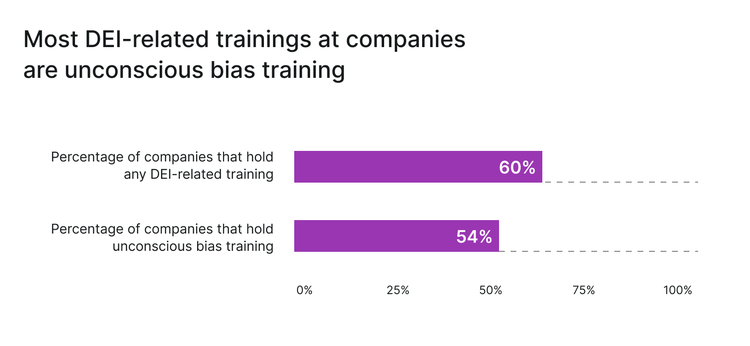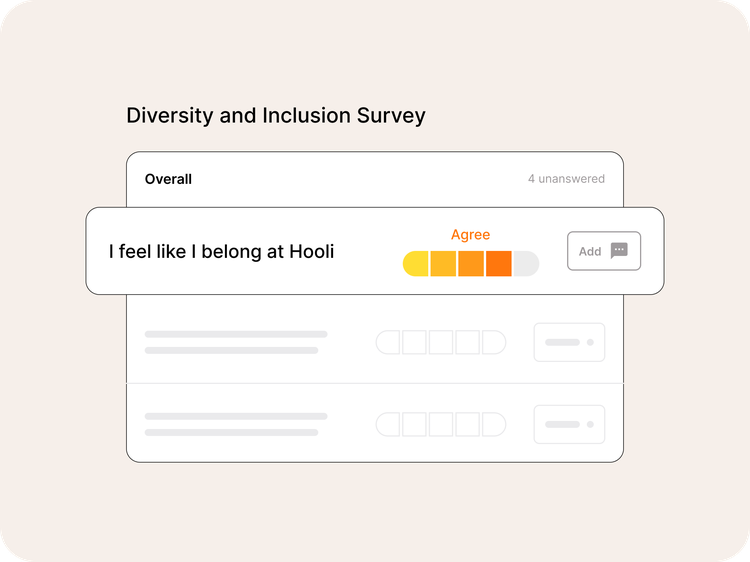
Written by

Senior Content Marketing Manager, Culture Amp
We all have unconscious biases. UCSF's Office of Diversity and Outreach describes these biases as "social stereotypes about certain groups of people that individuals form outside their conscious awareness." Unconscious biases (also known as implicit biases) are stereotypes that we've accidentally internalized and that we project onto others on the basis of their race, gender, disability status, citizenship status, or other group identity marker. The difficulties of overcoming unconscious biases are directly linked to our unawareness of these biases. To interrupt them, we need to have the proper systemic support in place.
Unconscious biases can lead individuals to inadvertently insult, offend, or otherwise hurt other people (i.e., commit a microaggression) or judge people to be less competent or qualified than they are (i.e., historically marginalized people). For instance, consider the criminalization of Black people or the infantilization of people with disabilities. Yet, it's important to note that unconscious biases are not always negative. Consider the stereotype that Asians are good at math – a generally positive trait. However, just because the judgment itself is "positive" doesn't mean that the individual or group benefits from the bias. In this case, the "good at math" stereotype has been strongly criticized for perpetuating a false narrative and obscuring inequities related to socioeconomic status.
Recently, many organizations have turned to unconscious bias (UB) training to address the corrosive impact unconscious biases have on workplace diversity, equity, and inclusion (DEI) and the overall employee experience. By surfacing biases from the unconscious to conscious awareness, UB training aims to help individuals recognize, question, manage, and mitigate their biases, hoping that this leads to overall improvements in workplace equity, inclusion, psychological safety, and sense of belonging.
While those are admirable goals, UB training has a contentious reputation. In this article, we explore unconscious bias training, the mixed research on its effectiveness, and what to consider when deciding whether to implement UB training in your workplace.
What does unconscious bias training look like?
Unconscious bias training programs are usually designed to raise awareness of participants' implicit biases and provide tools for addressing them. The overall goal is to reduce discriminatory behaviors and attitudes.
There are a wide variety of unconscious bias trainings, but the majority tend to conform to the following three-step process:
- Pre-test. Baseline bias levels are assessed using an implicit bias test (usually the Implicit Association Test).
- Training. Participants follow the training task(s).
- Post-test. Bias levels are reassessed to see if implicit bias has reduced after the training.
As a relatively new form of diversity training, UB training comes in various formats, both in-person and online. Some trainings involve a series of narrated PowerPoint slides or a series of videos watched over several weeks. Others are small, intensive workshops led by expert instructors.
Why is unconscious bias training controversial?
Due to the variety, lack of standardization, and the relative novelty of unconscious bias training, there is a lack of decisive evidence around the efficacy of UB training, both generally and for specific programs.
Many experts, including Aubrey Blanche, Culture Amp's Senior Director of Equitable Design, Product & People, do not recommend that organizations provide unconscious bias training.
Aubrey explains, "Overall, I wouldn't recommend unconscious bias training, as research has shown that if done poorly, it can cause significant backlash and deepen issues of bias in the workplace. Moreover, there is a lack of consistent evidence that shows that UB training has positive, long-term impacts. While there are some cases where training can be effective, it is never an appropriate first or only solution to DEI challenges."
That sentiment is widely shared among other DEI practitioners and researchers. For example, one study found that highlighting the prevalence of bias can make people more likely to express their biases. As a Scientific American article notes, "[Unconscious bias training] is well-motivated, but there's little evidence that it leads to meaningful changes in behavior."
The lack of empirical evidence in support of UB training is troubling, as our People Scientists have found that unconscious bias training is likely the primary DEI-related training offered to employees at this time. In Culture Amp's 2022 Workplace DEI report, our People Scientists reported that only 60% of companies hold general DEI training. However, 54% reported that they hold unconscious bias training specifically. This slight (6%) difference strongly suggests that most organizations are either offering UB training or no DEI-related training at all.

All this being said, we aren't arguing that all unconscious bias training programs will inevitably fail. UB training can be effective, if and only if the program is intentionally and carefully designed with research-based pedagogies. In the next section, we explore how organizations can make informed decisions on whether or not to implement some form of unconscious bias training among their workforce.
Improve the odds that UB training will work for you
If you're considering holding UB trainings at your company, here are some considerations that can help ensure that they work towards, instead of against, your company culture.
-
Establish the outcome you want to achieve.
In other words, why are you holding UB training at your company? For example, do you want to focus on increasing the representation of employees from diverse backgrounds? Or, are you hoping that the training will improve inclusion and belonging among marginalized employees?
Setting a concrete goal is a best practice for any DEI effort. Doing so creates accountability and signals that the company isn't being performative but is committed to achieving a measurable outcome. -
Remember that UB training isn't a "silver bullet" for eliminating bias and inequity in the workforce.
"The concept of unconscious bias training itself was largely created to protect against legal liability for bias within organizations – not as a strategy to drive equitable experiences for all employees," explains Aubrey.
For UB training to be useful, leaders must approach UB training intentionally as one part of their larger DEI strategy, while being mindful of UB training's limitations.
"I wouldn't recommend a company spends money on UB training unless they were already investing in a comprehensive audit and bias-mitigation strategy for their processes. The training's goal should be to give employees a common language to discuss and challenge bias, "continues Aubrey. "Without those other components, the training is unlikely to have any impact or be a good use of resources." - Ensure that the program gives actionable strategies for reducing bias. Simply being aware of our biases doesn't change them. Ensure that any UB training program you consider focuses on equipping attendees with actionable strategies for managing bias. This may seem obvious, but one study found that only 10% of training programs shared strategies that attendees could use to mitigate bias.
-
Be specific about your audience.
For example, if senior leaders at your company doubt the existence of DEI problems, it might be helpful to educate them on the impact of biases and the leaders' role in addressing them.
Ken Matos, Director of People Science, explains, "Throughout my career, I've seen UB training help decision-makers see how their actions contribute to the challenges without the defensiveness born of fears that making changes would reveal them as intentionally prejudiced.
Historically, I personally get the sense that when paired with an active EDI coach, UB training helped get leaders to realize changes were necessary, that those changes were systemic, not just individual (i.e., fixing policies and procedures, not just pushing out a few bad apples), and to consider options for improvement.
Unfortunately, it's since been converted into a general training without any follow-up (likely as an inexpensive way to show that a company is 'taking action' for legal liability purposes). Without the coaching to convert awareness into action, it can feel discouraging to the average employee who doesn't know what to do with this new knowledge to make things right. I believe this shift is the source of many of the problems people point out today and the likely source of the backlash my colleague Aubrey references in her work." -
Work with a DEI coach. UB training's core value is to create awareness of our biases, but awareness has little value without action. For people to get to sustained action, they need to learn (and practice) how to question their thoughts and beliefs – both conscious and unconscious – without getting distracted by guilt or shame for having biases. They need to ask themselves: "What characteristics activate my biases?", "What actions can I take to interrupt biased thinking and decision-making?", and "How might I work to ensure that biases (mine and others) don't get embedded in ongoing systems I can influence?"
Ken emphasizes, "This questioning piece is critical for mitigating one's unconscious biases, but it's also the piece that most often fails when it's just thrown out to the average employees to work through on their own without support. For this reason, I highly recommend following up UB training with some form of DEI coaching, especially for senior leaders who have the most effect on systemic processes and large numbers of employees." -
Measure progress and track the effectiveness of unconscious bias training. One good way to do this is to hold a pulse survey with specific DEI questions to understand the extent to which employees are engaging with the training.
However, it's not enough to collect feedback on employee participation and short-term sentiment. Ensure that you're also tracking whatever outcome the UB training intended to accomplish (e.g., improve diversity in leadership, reduce the number of employees who say they've experienced a microaggression, etc.).
Remember to track these outcomes over time to understand whether or not UB training is improving diversity, equity, and inclusion in the long term. If not, maybe UB training isn't the most effective form of DEI training for your workplace.
Last but not least, consider the alternatives. Aubrey suggests, "Look into your data to understand the specific types of challenges that underrepresented people at your company face. Perhaps anti-racism or allyship training may be more effective for your workplace."
If you aren't already collecting data on DEI at your company, consider holding a DEI survey like Culture Amp's DEI survey. Compared to a general engagement survey with some DEI questions, a DEI-specific survey empowers you with more targeted insights by allowing you to track the changing composition of your workforce, surface disparities in the employee experience across groups, quantify the impact of your DEI efforts, and more.

Find what works best for your workplace
Unconscious bias training may be one of the most common types of DEI training, but that doesn't mean it's the most effective type – especially not for your specific workplace. The most crucial point from this article is that UB training must be undertaken carefully and intentionally, using data and research-backed strategies, and incorporated as part of a larger DEI program. Otherwise, you may run the risk of harming instead of helping the state of DEI and historically marginalized people at your company.





